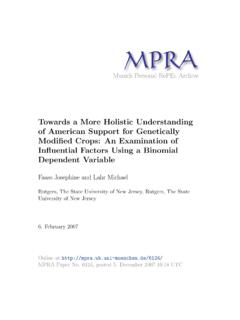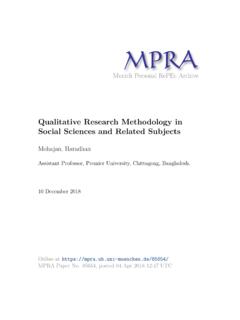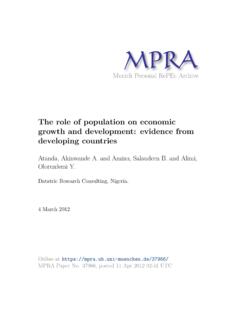Transcription of Role of Non-Governmental Organizations in Healthcare ...
1 Munich Personal RePEc ArchiveRole of Non-Governmental Organizationsin Healthcare Sector of IndiaDas, Nimai and Kumar, RajeevPublic Health Foundation of India16 September 2016 Online Paper No. 79402, posted 30 May 2017 04:27 UTC Published document URL: Authors: Nimai Das Rajeev Kumar Contributors: Indranil Mukhopadhyay Pritam Datta Supervisor: Sakthivel Selvaraj Public Health Foundation of India. All rights reserved. Health Economics Division Public Health Foundation of India (PHFI) Plot Number 47 | Sector 44 (Institutional Area) Gurgaon 122 002 | Delhi NCR | India URL: Published: September, 2016 PHFI is grateful to USAID-India for supporting the project Strengthening Ecosystem for Sustainable and Inclusive Health Financing in India (SESSIHFI) . Possible errors and omissions are unintentional and sole responsibility of the authors. Recommended citation: PHFI (2016).
2 Role of Non-Governmental Organizations in Healthcare Sector of India (Eds: Nimai Das and Rajeev Kumar). Public Health Foundation of India, Delhi. Page | iii Acknowledgments This report was based on a study carried out as part of the project Strengthening Ecosystem for Sustainable and Inclusive Health Financing in India (SESSIHFI) supported by USAID-India. It was prepared by the Public Health Foundation of India, comprising a team of researchers led by Dr. Nimai Das. The members of the team who contributed to the data analysis and conceptualization of the study include Dr. Indranil Mukhopadhyay, Mr. Rajeev Kumar and Mr. Pritam Datta. Thanks are also due to Anoop Vais, Manushi Sharma, Amit K Sahoo and other colleagues of the Health Economics Division who directly or indirectly helped in the preparation of the report. Special thanks to Mr. Biswadeep Palit and his team at MART-Noida for facilitating the primary survey of NGOs in India.
3 We would also like to express our indebtedness and gratitude to key officials in the National Accounts Division, Central Statistical Office, Ministry of Statistics and Programme Implementation, Government of India for helpful suggestions and providing the directory information of Non-Profit-Institutions Census 2007-08. The preliminary findings of this study have been presented at various fora including the National Health Systems Resource Centre, Ministry of Health & Family Welfare, Government of India. We would like to thank the members of these fora for their suggestions and comments on the study Role of Non-Governmental Organizations in Healthcare Sector of India. Sakthivel Selvaraj Senior Health Economist Public Health Foundation of India Page | iv List of Abbreviations CSO Central Statistical Office ICNPO International Classification of Non-Profit Organizations NAD National Accounts Division NGO Non-Governmental Organization NHA National Health Accounts NHM National Health Mission NHSRC National Health Systems Resource Centre NPI Not-for-Profit Institution NSS National Sample Survey OPD Out-Patient Department PHFI Public Health Foundation of India RBI Reserve Bank of India RMNCH Reproductive Maternal, Newborn and Child Health RoW Rest of the World SHA System of Health Accounts SHA State Health Accounts USAID United States Agency for International Development WHO World Health Organization Page | v Contents Executive Summary.
4 1 Chapter 1: Non-Governmental Organizations in Healthcare System .. 3 Background .. 3 Financial Architecture .. 3 Global and Local Perspectives .. 5 Scope in Contemporary Perspectives .. 6 Conceptualizing Non-Governmental Sector .. 7 Classifying Non-Governmental Sector .. 8 Chapter 2: Size and Structure of Non-Governmental Organizations .. 9 Overview .. 9 National Profile .. 9 Extent across States .. 10 Legal Status .. 12 Operational Areas .. 13 Employment Status .. 16 Revenue Generation .. 17 Expenditure Pattern .. 18 Chapter 3: Study of Health Financing for Non-Governmental Organizations .. 19 Study Outline .. 19 Observed Profile .. 20 Legal Status .. 20 Registration and Functioning .. 21 Operational Location .. 22 Operational Activities .. 23 Details of Health Activities .. 24 Main Activities under Health .. 25 Details about Outreach Activities .. 27 Pattern of Revenues.
5 28 Composition across Different Types of Organizations .. 29 Composition and Purpose of Health 32 Extent of Health Expenditure .. 33 Health Expenditure by Types of Care .. 35 Preventive and Curative Care Expenditure .. 36 Page | vi Chapter 4: Conclusion .. 38 Discussions and Policy Implications .. 38 Strength and Limitation of Study .. 39 Way forward .. 40 Annexure-I: Research Methodology and Estimation .. 41 Annexure-II: Sample Size across States .. 44 Annexure-III: Expenditure Breakups .. 45 Annexure-IV: Survey Schedule .. 46 Annexure-V: NHA Matrices Cross-works .. 55 References .. 56 List of Tables Table : Registered NGOs in first and second phase of CSO Census .. 11 Table : Distribution of NGOs by legal status across major states .. 13 Table : Distribution of NGOs by activities across major states .. 14 Table : Distribution of NGOs by involvement in health activities across major states.
6 15 Table : Distribution of NGOs by employment size across major states .. 17 Table : Observed pattern of registration versus functioning for NGOs across states .. 22 Table : Observed pattern of operational location for NGOs across states .. 22 Table : Observed pattern of outreach activities for NGOs across states .. 28 Table : Observed pattern of revenues for NGOs across states .. 28 Table : Observed pattern of revenues across size of NGOs .. 29 Table : Observed composition of grant receipts across states for 31 Table : Estimated current health expenditure across states for NGOs .. 33 Table : Distribution of health expenditure by type of care for NGOs .. 35 Table : Observed composition of curative care expenditure across states for NGOs .. 36 List of Figures Figure : Pattern of fund flow for Non-Governmental Organizations .. 4 Figure : Distribution on NGOs by institutions serving .. 10 Page | vii Figure : Rural urban distribution of NGOs.
7 10 Figure : Distribution of NGOs by legal status .. 12 Figure : Distribution of NGOs by operational activities .. 14 Figure : Distribution of NGOs by involvement in health activities .. 15 Figure : Distribution of NGOs by employment size .. 16 Figure : Extent of revenues by sources for general and health NGOs .. 17 Figure : Extent of expenditure in general and health sector NGOs .. 18 Figure : Observed pattern of NGOs by legal status across states .. 20 Figure : Observed pattern of NGOs by major operational areas across states .. 23 Figure : Observed pattern of activities under health for NGOs .. 25 Figure : Observed pattern of activities under health across states for different NGOs .. 25 Figure : Observed pattern of revenues for different NGOs .. 30 Figure : Observed composition of grant receipts from different sources for NGOs .. 32 Figure : Observed composition of single purpose grant for NGOs.
8 33 Figure : Observed composition of preventive care expenditure for 36 Page | 1 Executive Summary Who are the Non-Governmental Organizations ? Non-Governmental Organizations (NGOs) are called by various names across the world, such as third sector Organizations , non-profit Organizations , voluntary Organizations , charitable Organizations , community-based Organizations and so on with slightly modified scope and coverage. In India, they are often called as not-for-profit institutions, and officially defined as (a) Organizations that, (b) are not-for-profit and, by law or custom, do not distribute any surplus they may generate to those who own or control them, (c) are institutionally separate from government, (d) are self-governing and (e) are noncompulsory. To what extent are NGOs spread across India? As per the official information available from census of not-for-profit sector by National Accounts Division of Central Statistics Office, Government of India, about 3 million NGOs are registered with competent authorities with a rural-urban distribution of nearly 60:40.
9 However, only about million of them could be physically traced out by the Central Statistics Office with a visit about 70% NGOs during 2007-08. It has been observed in a group of 19 major states, five states - Uttar Pradesh, Andhra Pradesh, Kerala, Tamil Nadu and Maharashtra - account for 58% of NGOs in India. Bihar, Manipur and Chhattisgarh are the three bottom ranked states among the group of states. This group encompasses around 92% Health-NGOs in India, the top four states with respect to the Health-NGOs being Andhra Pradesh, Maharashtra, Rajasthan and Tamil Nadu. What functions do NGOs play in the health system? The primary focus of NGOs in the health sector are: establishing Healthcare institutions, fulfilling health and social needs of groups like women, elderly and vulnerable local communities, dealing with specific health issues such as alcoholism, promoting health rights, performing preventive health programs, and managing health finance and administration.
10 Some NGOs operate internationally and are concerned with global health issues. Some NGOs in India also play an important role in providing health care at the times of emergencies and natural disasters. How do NGOs generate resources? A common feature of NGOs is that those who pay them are often not the beneficiaries of their outcomes. NGOs generate resources from institutional and individual donors to facilitate achieving key goals and deliver outcomes to the targeted beneficiaries. According to Indian official estimates for the reference period 2007-08, NGOs generate about 70% of total revenue from grants and donations; the present study based on the primary survey for the reference Page | 2 period 2013-14 found that figure to be about 78% of total revenue. Nevertheless, the grant component is individually the highest part in revenue receipts during both 2007-08 and 2013-14.














